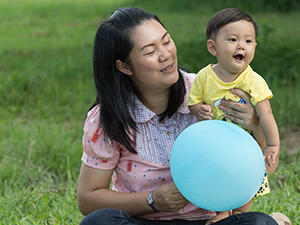Wonder of balloons – Baby
 Balloons are fascinating for your baby. They are colourful and light and are easier to focus on because they move more slowly than balls.
Balloons are fascinating for your baby. They are colourful and light and are easier to focus on because they move more slowly than balls.
Did you know?
Balloons can help focus your baby’s attention and motivate them to move. Balloons are very light and your baby’s touch can make them move out of reach. This can get them moving to get the balloon again.
Add language
When playing with your baby and a balloon, pause and wait for your baby to indicate they want ‘more’. They might do this by making body movements, or making eye contact with you, or calling out. This helps to keep joint attention and communication going.
Other development
Playing with balloons is an excellent way to help your baby develop their eye movements (this is known as visual tracking). Balloons move more slowly than balls, so your baby has more time to follow their movement as they float through the air.
As your baby develops they may want to crawl after a balloon. They become more aware of distance and will learn to coordinate their hands as they reach for a slowly moving balloon.
Your baby’s attraction to balloons can get them interested in exploring and discovering. They learn from watching, touching, squeezing, and putting their mouth onto the balloon. Your baby investigating things and how they work is the foundation of them learning science, technology and maths.
Variations
Babies are naturally attracted to faces. Drawing a simple face on a balloon for your baby to look at can hold their attention and focus.
Safety
Balloons can be a choking hazard for babies so need to be used with adult supervision.
Foil (Mylar) balloons provide an alternative which is less likely to pop loudly or break into small pieces.
Across the ages
All the activities listed on our “Play Ideas” page can be applied across different age groups See how the wonder of balloons can be fun for toddlers, children and playgroups.
Activities listed under “baby” are suitable for children under 12 months. This age is largely about babies exploring their own bodies and the world around them from the safety of a close relationship with their caregiver.

